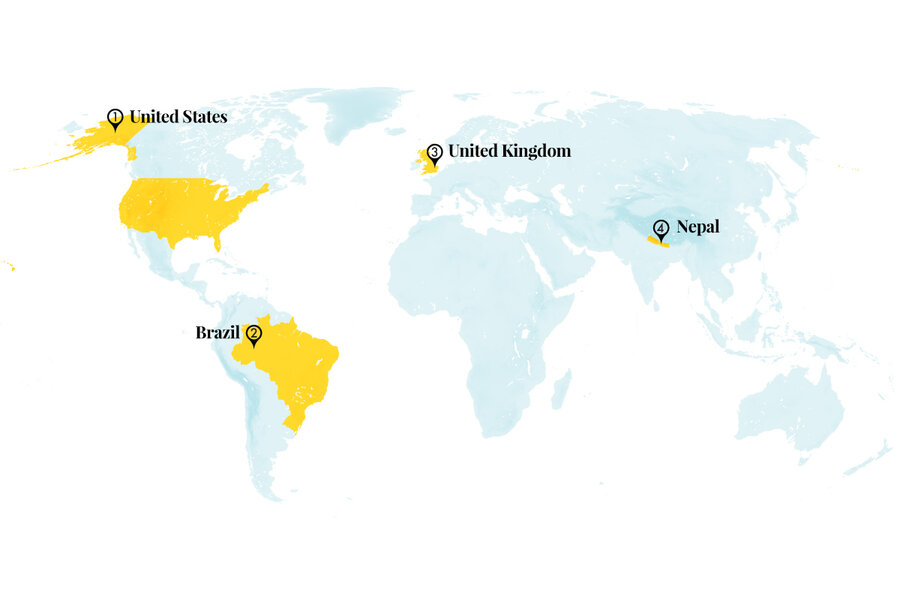Good intentions, good results: People pull together for forests and a fish
Loading...
1. United States
Alaska’s commercial fishing industry has become significantly safer in recent decades. Fishing used to be known as one of the state’s most dangerous industries, with dozens of deaths each year from machinery accidents and sinking vessels. Improved safety procedures, education, and catch quotas since the early 2000s have led to a steady decline in fatalities. As of mid-November, the industry had gone a record 17 months without a reported fatality.
Fishers moved away from derby-style commercial fishing, a risky race to bring in catch quickly, and more fishers are taking advantage of dockside examinations conducted by the Coast Guard to ensure their gear is in order and staff know how to use it. Gear like immersion suits and life rafts became a requirement, while crews had to train in safety drills and first aid. Many fishers now carry emergency position-indicating radio beacons so they can be located by rescue teams.
Why We Wrote This
A story focused onIn our progress roundup, Nepal and Brazil demonstrate how disparate interests can join forces to make change. That happens both when trust and responsibility are returned to the local level, and when the government’s power protects nature from overutilization.
A shift toward a safety-oriented culture is driving the change. “In the old days, fishermen would come to a class and think they’d be looking at their competitors,” said Jerry Dzugan, executive director of the Alaska Marine Safety Education Association. “Younger people seem to have a more positive attitude toward it.”
Source: Anchorage Daily News
2. Brazil
The Amazon’s biggest fish is back in a win for local ecosystems and river communities. The pirarucu, which can weigh up to 200 kilograms (441 pounds), had become threatened with extinction in the western part of the Brazilian Amazon, as fishing vessels illegally used large nets to sweep lakes. But in the late 1990s, a grassroots movement of rubber tappers campaigned for the federal government to create the Medio Jurua Extractive Reserve, which brought rubber tappers, riverine settler communities, and Indigenous people into cooperation to protect the local ecosystem. Today, these communities use the resources of the rivers and forest – within certain limits – to fish as well as produce açai, vegetable oils, and rubber.
A decade ago, there were just over 1,300 pirarucus in the lakes surrounding the community of São Raimundo; in 2020, there were more than 4,000. In another region, the fish population jumped from just under 5,000 to over 46,000.
Source: The Associated Press
3. United Kingdom
Rishi Rajpopat resolved a grammatical problem that has puzzled Sanskrit scholars for thousands of years. The Ph.D. candidate from India was studying at the University of Cambridge and had hit a wall. “I closed the books for a month and just enjoyed the summer – swimming, cycling, cooking, praying and meditating,” he said. “Then, begrudgingly I went back to work, and, within minutes ... it all started to make sense.”
In English, Sanskrit is familiar from words like “mantra” and “guru,” and is spoken today by some 25,000 people in India. The ancient language has been used for centuries in science, philosophy, and literature. Taught by revered philologist Panini some 2,500 years ago, a “metarule” for the language says that when two equal rules conflict, the later rule “in the grammar’s serial order wins.”
But Dr. Rajpopat argued that between rules applying to the left and right sides of a word, Panini intended readers to choose the right-side rule. The reinterpretation leads for the first time to grammatically correct results with few exceptions. Dr. Rajpopat’s supervisor said the discovery will revolutionize the study of Sanskrit.
Sources: University of Cambridge, BBC
4. Nepal
Nepal grew back huge swaths of forest over four decades. In 1980 the government began returning degraded forest to villages, under the stipulation that communities protect and manage their areas – part of a massive replantation initiative supported by foreign aid.
With the responsibility of local control, villagers organized themselves in groups, planting seedlings and protecting saplings. Between 1992 and 2016, the percentage of tree cover almost doubled, from 26% to 45%. Billions of aid dollars still to come will help support forest conservation and the reduction of carbon emissions.
In these areas, improved populations of wildlife such as tigers are an increasing concern for humans. And there have been tensions between local residents and government troops who protect nearby reserves from poaching. But they share a common goal. “The trees, the animals, they are all our friends,” said Khadga Bahadur Karki, who began renewal work some 40 years ago. “We can’t live without them.”
Source: The New York Times
World
Scooters and mopeds are driving the global electric vehicle revolution. Road transportation is responsible for an estimated 12% of emissions worldwide. In 2021, some 275 million electric motorcycles and other small vehicles were in use around the world – more than 16 times the number of electric passenger cars. Nearly half of all the two- and three-wheelers sold that year were EVs. Much of the growth has taken place in Asia, where densely packed cities, relatively warm temperatures, and government incentives make scooters as desirable as they are cost-effective.
While China is the dominant market, e-mobility companies are expanding in places like India and Indonesia, the latter of which plans to use subsidies to put 2 million electric motorcycles on the road by 2025. Two- and three-wheelers are less common in North America and Europe, but some say the tides may be changing toward smaller-scale e-mobility there, too. “We call them ‘Gen EV,’ because these kids are growing up and EVs are just a normal thing for them,” said Dong Tran, founder of the e-motorcycle startup Ryvid.
Source: Protocol











